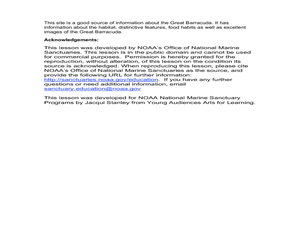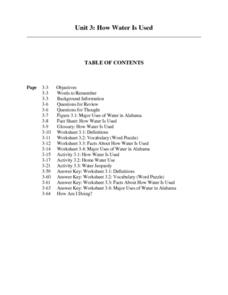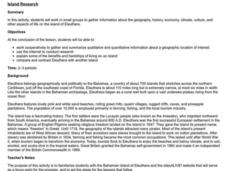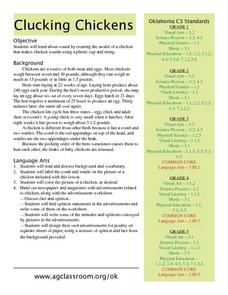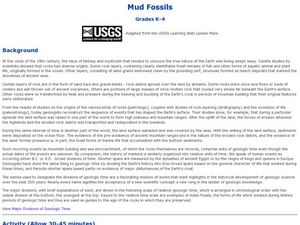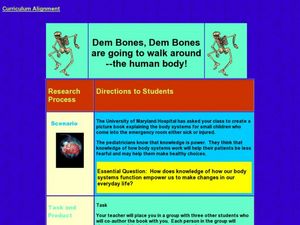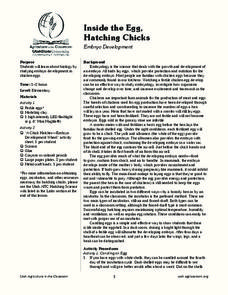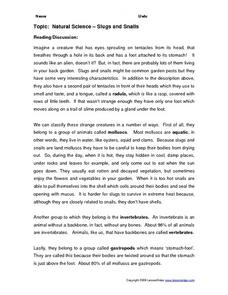Curated OER
Case of the Missing Pumpkin
Students explore the process of decomposition. In this science lesson, students carve a pumpkin and observe as it decomposes. Students compare the changes to an uncarved pumpkin. Students write about the disappearing pumpkin.
Curated OER
The Great Barracuda
Students explore oceanography by researching the great barracuda. In this animal life lesson, students read several vocabulary terms dealing with ocean life and examine a drawing of a barracuda. Students examine the many...
Curated OER
How Water Is Used
Students explain importance of water to life processes, discuss amount of daily home water use, and discuss major water uses in Alabama.
Curated OER
Island Research
Students will work in small groups to gather information about the geography, history, economy, climate, culture, and other aspects of life on the island of Eleuthera. Lesson contains adaptations for all levels.
Curated OER
Island Survival
Students participate in a simulation of life on a deserted island. They apply their critical thinking skills and knowledge of oceans and islands to "survive" and ultimately return to safety. Lesson contains adaptations for all levels.
Curated OER
Clucking Chickens
A comb, wattle, and beak are three characteristics that describe a chicken. Your class can explore the life of a chicken through reading, art, movement, and music. Using a plastic cup and string, they'll create a pretend chicken that...
Curated OER
Research Aardvarks
In this researching the nocturnal animal aardvark instructional activity, learners find the meaning, location where it lives, life span and diet, describe its anatomy and record interesting facts, and record references. Students answer 8...
Curated OER
Those Busy, Buzz'n Worker Bees
Students research information on worker bees. In this insect lesson, students review the body parts of insects and how bees find flowers. They discuss compound and simple eyes and the life cycle of a worker bee.
Curated OER
The Many Uses of Trees
Young scholars list all the ways humans use trees and tree by products. In this lesson students watch a video, discuss the impact trees have on humans, and research common products made from trees. The young scholars use their findings...
Curated OER
Comparing Sea Horses and Knights
Students investigate sea horses and knights. In this marine biology lesson, students read the book How to Hide an Octopus and discuss the purpose of camoflage. Students research knights and sea horses and record their research on...
Curated OER
Penguin Worksheet
In this animal science activity, students answer fifteen questions about penguins. The questions included true or false and fill in the blanks. Students will need prior knowledge about penguins to complete this activity. The questions...
Curated OER
Local Habitats
Students create dioramas that depict a habitat. In this habitat lesson, students use a variety of art items to develop either a marine, freshwater/pond, or forest habitat in a box. They write an expository essay about their habitat, and...
Curated OER
Cell Structure and Function
Students discuss scientific advances brought about by the Mars Surveyor Space Program which impact on daily life, identify laboratory apparatus like microscopes, slides and coverslips, and use the microscopes to view cells and organisms.
Curated OER
Build an Anchialine Pond
Students explore biology by conducting a nature experiment. In this pond examination lesson, students utilize recycled materials, play-doh and water to recreate a pond and its inhabitants. Students identify the different elements within...
Curated OER
The Sense Of Touch
Students explore the sense of touch. For this science lesson plan, students participate in hands-on activities that broaden their perspectives pertaining the sense of touch.
Alabama Learning Exchange
The Five Senses: How They Relate to our World
Students explore the five senses and the significance of each sense. In this five senses and diversity lesson, students listen to You Can't Smell a Flower With Your Ear by Joanna Cole and take a walk observing opportunities to use all...
Curated OER
Schooling Fish
Students make fish models. In this fish behavior lesson plan, students create lanternfish fishsticks, learn how a school of fish live, eat and swim together, examine the predator-prey relationship, and read the book Swimmy to...
Curated OER
Mud Fossils
Students observe real fossils. In this science lesson, students make their own mud fossils by pressing material into the mud and letting it dry in the sun for 3-4 days. Students then get the fossils out displaying their mud...
Curated OER
Dem Bones, Dem Bones are Going to Walk Around: The Human Body
Students explore human anatomy by creating a science book in class. In this skeletal structure lesson, students identify the different body systems such as muscular, nervous, skeletal, and digestive. Students create a picture book which...
Curated OER
Inside the Egg, Hatching Chickens
Students explore how an egg becomes fertilized. In this biology lesson, students "candle" a variety of eggs in order to determine which ones have been fertilized and which ones haven't. Student use paper plates to create a graphic on the...
Curated OER
Systems of the Human Body
Students inquire about human anatomy by completing a worksheet. In this body systems lesson plan, students discuss the importance of a self-regulating body and how the skeletal, muscular, respiratory and digestive system all take...
Curated OER
Leaves and Photosynthesis
For this science worksheet, students read detailed information about green plants and the photosynthesis process. In this fill in the blank and true and false worksheet, students answer twelve questions.
Curated OER
Oil on the Beach
Students explore how oil pollutes the oceans. For this science lesson, students investigate various materials that could be used to clean up an oil spill. Students discuss which materials worked best and how humans can reduce oil spills.
Curated OER
Slugs and Snails
Slugs and snails are the focus of this life science worksheet. Student read a selection on these animals, then answer ten comprehension questions. Then, students must draw an "alien portrait" using the characteristics of slugs and snails...

